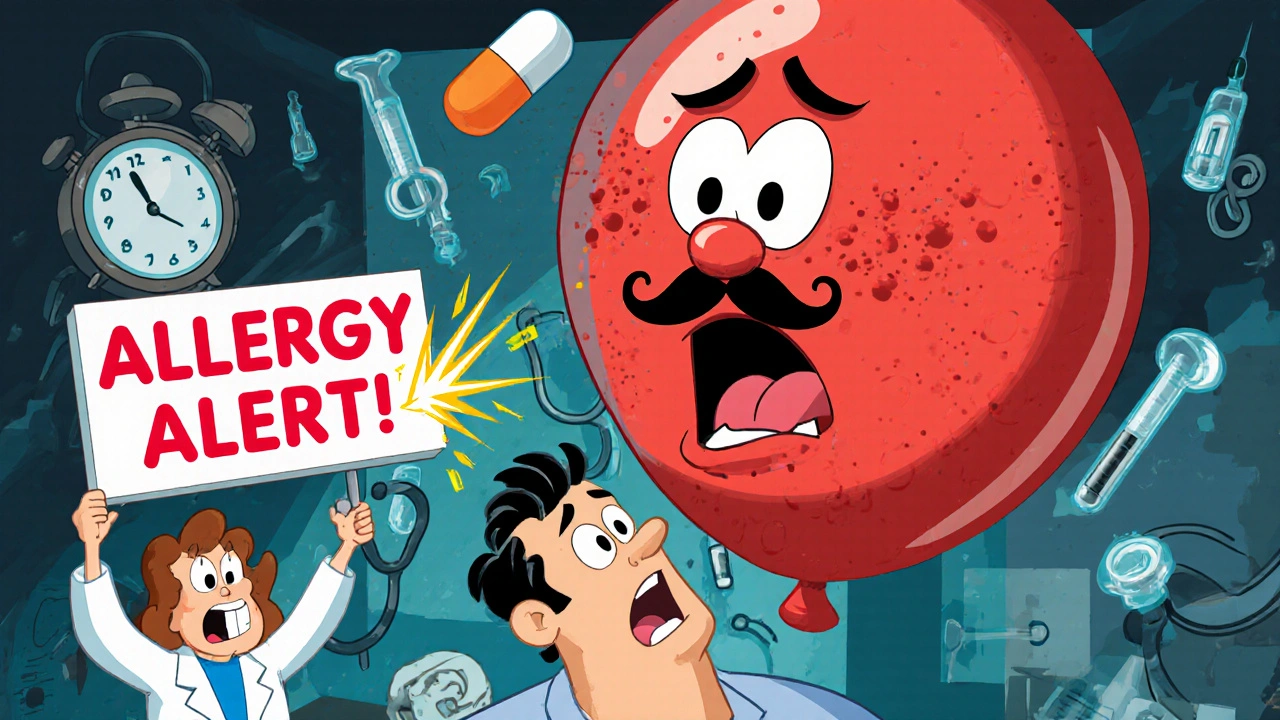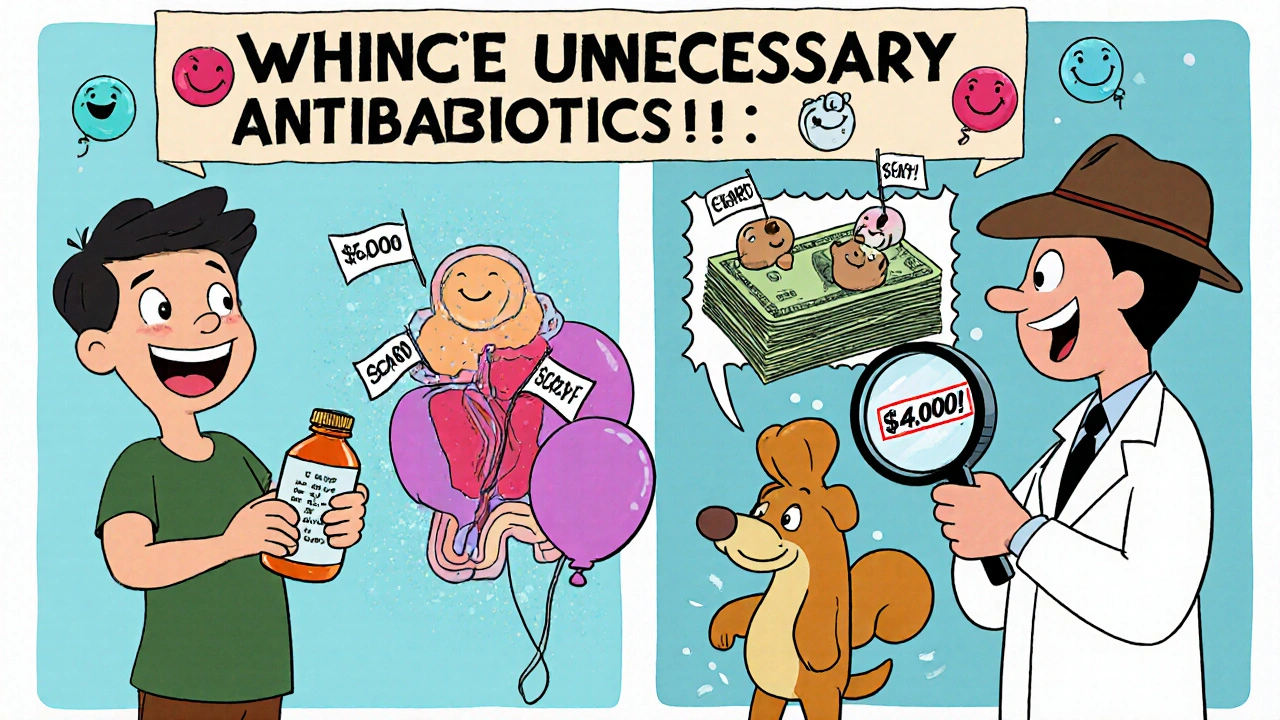When you take a new medication, it’s normal to worry about what might happen. Maybe your stomach feels upset. Maybe you get a rash. Maybe you feel dizzy. But here’s the thing: not every strange feeling means you’re allergic. In fact, most reactions aren’t allergies at all. They’re side effects. And mixing them up can cost you more than just discomfort-it can limit your treatment options, raise your bills, and even put your health at risk.
What Are Medication Side Effects?
Side effects are predictable, known reactions to a drug. They happen because the medicine does more than just treat your condition. For example, metformin helps lower blood sugar, but it also irritates the gut in 20-30% of people, causing nausea or diarrhea. Statins reduce cholesterol, but about 5-10% of users get muscle aches. These aren’t accidents-they’re documented in the drug’s official labeling by the FDA, with exact percentages listed.
Side effects usually show up within hours or days of starting the medicine. They often get better over time as your body adjusts. Most people find that nausea from metformin fades after two weeks if they take it with food. Dizziness from blood pressure meds often disappears after a few days. About 70-80% of common side effects go away on their own within 2-4 weeks, according to NIH clinical data.
The key? Side effects don’t involve your immune system. They’re just the drug doing its job-sometimes too well, or in the wrong place. That’s why doctors can often manage them: lower the dose, take it with food, switch to a similar drug, or add another medication to counteract it.
What Is a True Drug Allergy?
A drug allergy is different. It’s your immune system going haywire. It sees the medicine as an invader-like a virus or pollen-and attacks it. This isn’t about how the drug works. It’s about your body’s overreaction.
True allergies come in two main types. Immediate reactions, mediated by IgE antibodies, hit fast: within minutes to two hours. Symptoms include hives, swelling of the lips or throat, wheezing, or anaphylaxis-a life-threatening drop in blood pressure. Delayed reactions take longer. A rash might appear 48-72 hours after taking the drug, or even up to two weeks later. These are often T-cell driven and show up as red, itchy patches across the skin.
Penicillin is the big one. About 80% of all severe drug allergies involve it. But here’s the shocking part: 80-90% of people who say they’re allergic to penicillin aren’t. When tested properly, most turn out negative. Yet they still avoid it-and end up on broader-spectrum antibiotics that cost $4,000 more per patient annually, according to Brigham and Women’s Hospital.
Other common allergy triggers include sulfonamides (like Bactrim), NSAIDs (like ibuprofen), and certain chemotherapy drugs. Unlike side effects, you can’t adjust the dose to avoid an allergic reaction. Even a tiny amount can trigger it. And once you’ve had one, your body remembers.
How to Tell the Difference
Here’s a simple way to separate them:
- Timing: Side effects start within hours or days and often improve. Allergic reactions can be immediate (minutes) or delayed (days), but they don’t fade with time unless you stop the drug.
- Symptoms: Nausea, dizziness, dry mouth, fatigue? Likely side effects. Hives, swelling, trouble breathing, blistering skin? That’s an allergy.
- Reproducibility: If you take the drug again and get the same reaction, it’s likely not a side effect-it’s an allergy. Side effects can be inconsistent; allergies are consistent.
- Dose dependence: Side effects often get worse with higher doses. Allergic reactions happen at normal doses-even a single pill.
For example: if you take lisinopril and develop a dry cough, that’s a known side effect-not an allergy. It’s not your immune system. It’s the drug affecting your airway nerves. Switching to a different blood pressure med usually fixes it. But if you take amoxicillin and your face swells up in 20 minutes? That’s an allergic reaction. You must avoid it forever.

Why This Matters More Than You Think
Mislabeling a side effect as an allergy has real consequences. A 2021 JAMA Internal Medicine study found that 80-90% of people who say they’re allergic to penicillin aren’t. Yet they’re still denied the safest, cheapest, most effective antibiotic for infections like pneumonia or strep throat. Instead, they get broader-spectrum drugs like vancomycin or ciprofloxacin. These drugs are more expensive, more toxic, and more likely to cause antibiotic-resistant infections like MRSA.
Dr. Elina Jerschow from the American College of Allergy, Asthma & Immunology says mislabeled penicillin allergies increase the risk of MRSA infection by 69%. That’s not a small risk. It’s life-threatening.
And it’s not just penicillin. People avoid statins because they think muscle pain is an allergy. They skip NSAIDs because they got a headache. They refuse antibiotics because they had diarrhea once. Each time, they’re limiting their care-not because they’re allergic, but because they don’t know the difference.
Healthcare costs climb because of this confusion. The U.S. spends $1.1 billion a year on unnecessary antibiotics, longer hospital stays, and avoidable complications-all because of misdiagnosed drug reactions. The American Medical Association says improper documentation alone wastes $1.5 billion annually.
What Should You Do?
If you think you’re allergic to a drug, don’t just assume. Talk to your doctor. Ask:
- What exactly happened when I took the drug?
- How long after taking it did the reaction start?
- Did I have trouble breathing, swelling, or hives?
- Has this happened more than once?
For penicillin, the CDC recommends a three-step process:
- Review your history-60% of people can be cleared just by answering questions.
- Get a skin test-this has a 97% negative predictive value. If it’s negative, you’re likely not allergic.
- Do an oral challenge-take a small dose under supervision. Less than 0.2% of low-risk patients react.
These tests aren’t scary. They’re safe, quick, and life-changing. Many people who thought they couldn’t take penicillin end up being able to-saving money, avoiding resistant infections, and getting better care.
For other drugs, allergists use blood tests like the basophil activation test (BAT), approved by the FDA in 2023. It’s more accurate than skin tests alone, with 85% sensitivity and 95% specificity.

What About Future Testing?
Science is getting smarter. Pharmacogenomics-testing your genes before prescribing-is now standard for some drugs. For example, if you carry the HLA-B*57:01 gene, you’re at high risk of a severe reaction to abacavir (an HIV drug). Screening for this gene cuts allergic reactions from 8% to 0.4%.
More hospitals are using electronic alerts to flag potential mislabeled allergies in patient records. Pilot programs show a 35% drop in unnecessary antibiotic use after these alerts are added.
But here’s the catch: only 10% of U.S. allergists have the capacity to test for drug allergies. That’s why primary care doctors need to learn how to spot the difference. Training programs have shown a 55% improvement in accurate documentation after just a few hours of education.
Bottom Line
Not every bad reaction is an allergy. Most aren’t. Side effects are common, manageable, and usually harmless. Allergies are rare, dangerous, and require lifelong avoidance. Confusing the two doesn’t protect you-it harms you.
If you’ve ever said, ‘I’m allergic to this medicine because it made me sick,’ pause. Ask yourself: Did I have trouble breathing? Did my skin swell? Did it happen fast? If not, it’s probably not an allergy. Talk to your doctor. Get tested. Don’t let a misunderstanding cost you your health-or your future treatment options.
Knowing the difference isn’t just medical knowledge. It’s power.
Can you outgrow a drug allergy?
Yes, some people do-especially with penicillin. Studies show that 80% of people who had a true penicillin allergy in childhood lose their sensitivity after 10 years. That’s why retesting later in life is often recommended, especially if you’ve never been formally tested. Never assume you’re still allergic without confirmation.
Is a rash always a sign of a drug allergy?
No. Many drugs cause rashes as side effects without involving the immune system. Viral infections, heat, or even stress can cause similar rashes. A true allergic rash is usually itchy, widespread, and appears 1-2 weeks after starting the drug. If it’s mild and localized, it might just be a side effect. Only a doctor can tell the difference.
Can you have a side effect the first time you take a drug?
Absolutely. Side effects don’t require prior exposure. If a drug causes nausea, dizziness, or fatigue, it can happen on the very first dose. Allergies can too-but only if your immune system has been sensitized before, usually through cross-reactivity (like a past infection or unrelated exposure to a similar chemical).
What should I do if I think I had an allergic reaction?
Stop the drug immediately. If you have trouble breathing, swelling of the face or throat, or feel faint, call emergency services. Afterward, schedule an appointment with an allergist. Don’t just tell your doctor you’re allergic-ask for testing. Document exactly what happened: timing, symptoms, duration. This helps avoid future misdiagnosis.
Are over-the-counter drugs safer than prescription ones?
No. NSAIDs like ibuprofen and naproxen cause more allergic reactions than many prescription drugs. Acetaminophen can trigger severe skin reactions in rare cases. Just because a drug is sold without a prescription doesn’t mean it’s harmless. Always read the label and know your limits.
Can I take a different drug in the same class if I’m allergic?
Sometimes, but not always. Penicillin and amoxicillin cross-react in 90% of cases. If you’re allergic to one, avoid the other. But not all drugs in a class behave the same. For example, someone allergic to sulfamethoxazole might tolerate a different sulfonamide if tested. Never assume-ask your doctor or allergist to check for cross-reactivity.
Does having one drug allergy mean I’ll have more?
Not necessarily. People with one true drug allergy are slightly more likely to react to others, but it’s not guaranteed. Most drug allergies are specific to one molecule. If you’re allergic to penicillin, you’re not automatically allergic to aspirin or insulin. Each reaction needs to be evaluated on its own.
Can I be allergic to a drug I’ve taken before without problems?
Yes. Allergies can develop after repeated exposure. Your immune system can suddenly start recognizing a drug as dangerous-even if you took it safely five times before. This is why doctors warn against assuming safety based on past use. Always monitor for new symptoms.





Jennifer Shannon
November 22, 2025 AT 22:04Wow, this is one of those posts that makes you realize how much we just accept things without questioning them-like, I thought I was allergic to ibuprofen because I got a headache once, but now I’m wondering if I just have a sensitive nervous system or maybe I was dehydrated? It’s wild how we label ourselves based on single experiences and then carry those labels around like they’re engraved in stone. I’ve seen friends avoid entire drug classes because of one bad night, and honestly, it’s scary how often that’s just a side effect masquerading as an allergy.
Bryson Carroll
November 24, 2025 AT 03:11So let me get this straight-you’re telling me most people who say they’re allergic to penicillin are just wrong and that’s why we’re overprescribing antibiotics? Wow. So the entire healthcare system is basically built on a collective misunderstanding? And now I’m supposed to believe that 80% of people who think they’re allergic aren’t? That’s not just ignorance-that’s systemic negligence. Someone’s making money off this confusion and it’s not me.
Suzan Wanjiru
November 25, 2025 AT 01:24Side effects are annoying but manageable. Allergies are life-threatening. The key is knowing the difference. If you had hives or swelling or trouble breathing, that’s an allergy. If you just felt nauseous or tired, that’s probably not. Don’t guess-ask for testing. Penicillin skin tests are quick, cheap, and accurate. Stop assuming. Get checked.
Henrik Stacke
November 25, 2025 AT 13:51I must say, this is one of the most lucid and urgently necessary explanations I’ve encountered in recent medical discourse. The distinction between pharmacological side effects and immunological hypersensitivity is not merely academic-it is, quite literally, a matter of life, death, and fiscal responsibility. The fact that so many patients are denied first-line therapies due to misattribution is not only tragic but criminally negligent. I urge all readers to consider re-evaluation, particularly if their alleged allergy dates back to childhood or was based on a vague anecdote.
Manjistha Roy
November 26, 2025 AT 09:24This is so important for people in developing countries too-we don’t always have access to allergists or skin tests, but we do have community health workers who can help people recognize the signs. If someone had a rash after taking amoxicillin but no swelling or breathing trouble, they might not need to avoid all penicillins forever. We need more education at the grassroots level, not just in hospitals.
Jennifer Skolney
November 26, 2025 AT 17:13Thank you for this!! I thought I was allergic to statins because I got muscle pain, but after reading this I talked to my doctor and we lowered the dose and added CoQ10-no more pain and my cholesterol is down!! I was so scared to take anything for years 😊
Olanrewaju Jeph
November 26, 2025 AT 21:25The assertion that 80–90% of individuals who self-report penicillin allergy are not truly allergic is corroborated by multiple peer-reviewed studies, including those published in JAMA Internal Medicine and the Journal of Allergy and Clinical Immunology. The economic burden of alternative antibiotic use, compounded by increased rates of MRSA and C. difficile infections, underscores the public health imperative to correct this misconception. Clinical pathways for de-labeling, as outlined by the CDC, must be integrated into primary care protocols without delay.
Dalton Adams
November 27, 2025 AT 14:49Oh please, you think this is groundbreaking? I’ve been telling people this for years. You don’t get an allergy because your stomach hurt after taking metformin. That’s like saying you’re allergic to rain because you got wet once. And don’t even get me started on people who say they’re allergic to acetaminophen because they got a headache-dude, that’s a side effect of being human, not an immune response. I’ve got a friend who refuses all NSAIDs because she once got a rash from ibuprofen during a viral infection. She’s been on opioids for a sprained ankle. 😑
Kezia Katherine Lewis
November 29, 2025 AT 10:34The immunological mechanisms underlying drug hypersensitivity are profoundly distinct from pharmacodynamic side effects. The IgE-mediated immediate reaction versus T-cell-mediated delayed hypersensitivity represents two separate biological cascades, each with unique diagnostic criteria and clinical implications. The underutilization of validated tools such as the basophil activation test (BAT) and pharmacogenomic screening (e.g., HLA-B*57:01 for abacavir) represents a critical gap in precision medicine implementation, particularly in resource-constrained primary care settings where diagnostic confidence remains low.
JD Mette
November 30, 2025 AT 10:29I used to think I was allergic to codeine because I felt dizzy. Turns out, I just metabolize it slowly. Took me three doctors and two years to figure it out. I wish I’d known this earlier.
Kane Ren
November 30, 2025 AT 22:55This is exactly the kind of info we need more of. So many people are walking around with unnecessary restrictions on their meds, and it’s not because they’re being careless-it’s because no one ever explained the difference. Thanks for breaking it down so clearly. You just might have saved someone’s life today.